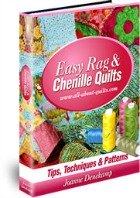Washing Applique Blocks
The process of washing applique blocks often takes a backseat (or forgotten completely) once these beautiful blocks are beautifully sewn together and ready to be assembled into the quilt top. However, washing appliqué blocks is an essential step in the overall quilting process. It aids in preserving the longevity of your projects, as well as enhancing their visual appeal.
Doing this vital step not only rids the blocks of the dirt and oils accrued from our hands during constructing them but also efficiently removes any residual glue, markings from fabric pencils, or deposits of spray starch, particularly if you've used them. This is, especially important if lighter colored fabrics have been used in creating your appliqué blocks, as it aids in maintaining their fabulous appearance over time.
Given the delicate nature of most appliqué blocks, the recommended washing method is by hand. Following are some detailed steps bolstered by tips to help you understand how to clean them properly and effectively.
Below is a video by Simple Bird Studio showing how to hand wash your appliqué blocks.
Preparation:
Begin by acquiring a product such as Synthrapol, a mild detergent specifically crafted to prevent dyes from bleeding, while ensuring the thorough removal of fingerprints, dirt, oil, and other such impurities that could have been gathered on your blocks during the creative process.
Washing Applique Blocks Instructions:
1. Firstly, mix Synthrapol into a basin/bucket of hot water. The heat aids in the cleaning process by opening up the fibers in your fabric, thereby making them more susceptible to thorough cleaning.
2. Gently place your appliqué block in the prepared water, making sure that the entire block is wet.
3. The next step is a simple yet vital one - patience. Allow the block to soak for at least two hours. However, to achieve optimal results, it is often recommended to leave the block to soak overnight, if time permits.
4. Rinse the soaked block in cold water two to three times, thereby ensuring the complete removal of any residual detergent or loosened impurities. Cold water is used in this stage as it aids in closing the fibers that were opened up by the hot water, thereby locking in the cleanliness achieved from the washing process.
5. Gently press the block to remove excess water. Be careful in this step as aggressive wringing may distort the shape of your block or risk the integrity of your appliqué.
After washing, it is equally important to properly dry your appliqué blocks. Avoid the temptation of using a dryer or laying them out in the sun as these methods may lead to shrinkage or color fading.
Drying Instructions:
1. To begin, lay the washed block flat on a clean surface lined with cotton batting. Avoid using a towel as the fibers could potentially leave undesirable crease marks on your block.
2. Use a clean iron to press and dry, preferably from the wrong side. This minimizes potential damage to the appliqué.
3. Several cotton pressing cloths should be used in conjunction with the iron. Apart from evenly distributing the heat, these cloths also protect your block from acquiring direct heat damage.
By ensuring that your appliqué blocks are washed and dried properly using the techniques mentioned above, you contribute to their preservation and prolong their lifespan. Happy Quilting!
My Amazon ads are my affiliate links. Thank you.



New! Comments
Have your say about what you just read! Leave me a comment in the box below.